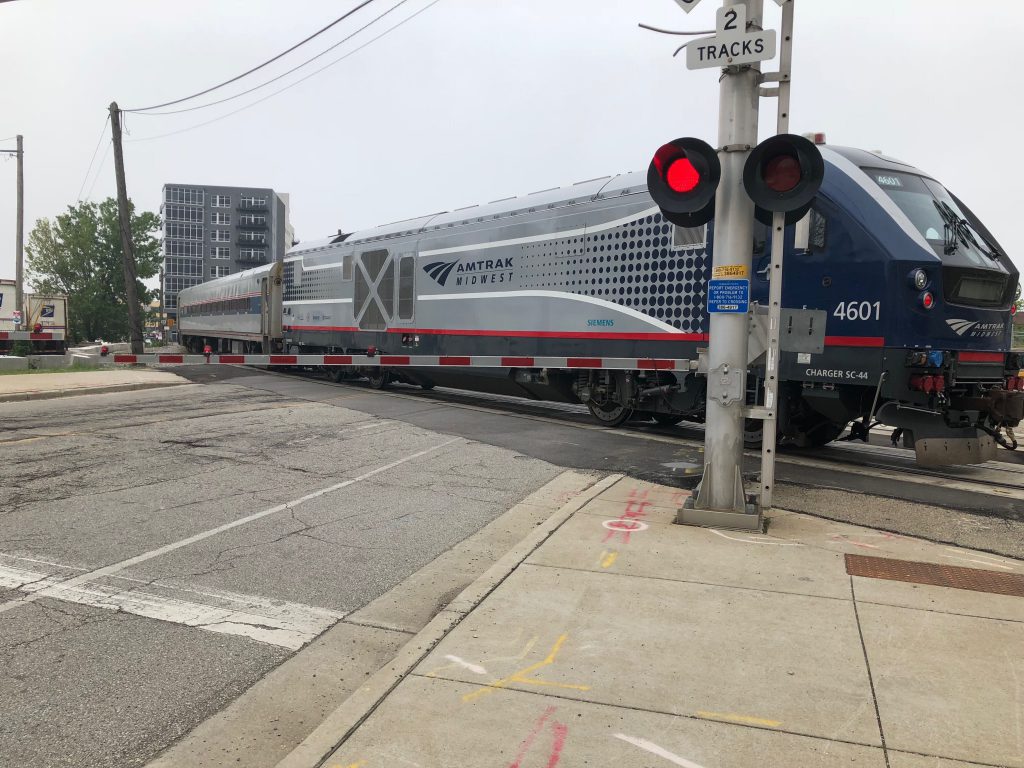Trains Will Roll Faster Through Downtown
Signal upgrades are part of effort to expand Amtrak Hiawatha Service

An Amtrak Hiawatha Service train crosses N. Plankinton Ave. near the Milwaukee Intermodal Station. Photo by Jeramey Jannene.
As anyone who has ever been stuck waiting for a train to cross N. Plankinton Ave. or N. 13th St. can tell you, freight trains roll slowly through downtown Milwaukee and the Milwaukee Intermodal Station.
The corridor, owned by Canadian Pacific, is used by 16 passenger trains and approximately 20 freight trains daily.
A $2.7 million federal grant aims to boost speeds by providing for the installation of a $5.4 million centralized train control system on approximately two miles of track surrounding the Milwaukee Intermodal Station. The system would allow for automatic and remote-controlled track switching. It’s one piece of a bigger puzzle to expand Amtrak Hiawatha Service from seven to 10 daily round trips.
The grant comes on the heels of a recent $5 million award from the FRA that will support the construction of a $10.1 million second platform at the Milwaukee Airport Rail Station. Currently south and northbound trains use the same platform, causing congestion for both passenger and freight trains. “The project will also improve safety and access for passengers with disabilities by eliminating the use of an emergency platform,” said the FRA in a February 2019 press release.
Both grants support a $195 million plan to expand daily Amtrak Hiawatha Service between Milwaukee and Chicago. The Wisconsin Legislature’s Joint Committee on Finance allocated $35 million earlier this week to fund the state’s matching share to access the grants.
Plenty of work remains to be done. The biggest project on the Wisconsin side of the line, the Muskego Yard bypass, is estimated to cost between $24 million and $60 million. The bypass would route freight trains away from the downtown Milwaukee train station and involve signal, bridge and track upgrades.
The biggest challenge remains in Illinois. The Illinois Department of Transportation is refusing to back an environmental assessment of the Hiawatha’s expansion based on the objections of the suburban communities of Glenview and Lake Forest. Illinois and Wisconsin officials are examing options for an alternative route.
The route posted record ridership in 2018, doubling since 2003.
New Passenger Cars
Good news is on the way even if the service expansion never happens. A late 2018 state report notes that riders of one of the two Hiawatha trainsets can expect to ride in new cars. Eighty-eight single-level coaches from Siemens are in production for use on Midwest Amtrak routes and will enter service in the next three years. One set of the Amfleet passenger cars in use on the Hiawatha, which first entered service in 1981, will be replaced as part of the multi-state order.
Faster and more fuel-efficient locomotives entered service in 2017. A new, $22 million concourse at Milwaukee Intermodal Station opened in 2016.
Made-in-Milwaukee trainsets from Talgo, which the state paid for but never put into service and now doesn’t own, remain in storage in Indiana. Former Governor Scott Walker and the Republican-led Legislature rejected a funding plan to put the trainsets into service following an earlier rejection of an $810 million federal grant that would have expanded the Hiawatha Service to Madison. Many of the projects the state is seeking funding for today would have been paid for as part of the grant.
A separate proposal to add a second Amtrak Empire Builder train between Minneapolis-St. Paul and Milwaukee is undergoing environmental engineering. Railroad related infrastructure costs for that project are estimated to range from $55 million to $76 million according to a state report.
If you think stories like this are important, become a member of Urban Milwaukee and help support real independent journalism. Plus you get some cool added benefits, all detailed here.
Transportation
-
MCTS Adds 28 New Buses
 Jul 13th, 2024 by Graham Kilmer
Jul 13th, 2024 by Graham Kilmer
-
MCTS Designing New Bus Shelters
 Jul 10th, 2024 by Graham Kilmer
Jul 10th, 2024 by Graham Kilmer
-
MCTS Updates RNC Bus Detours To Better Serve Downtown, Riders
 Jul 9th, 2024 by Jeramey Jannene
Jul 9th, 2024 by Jeramey Jannene





















